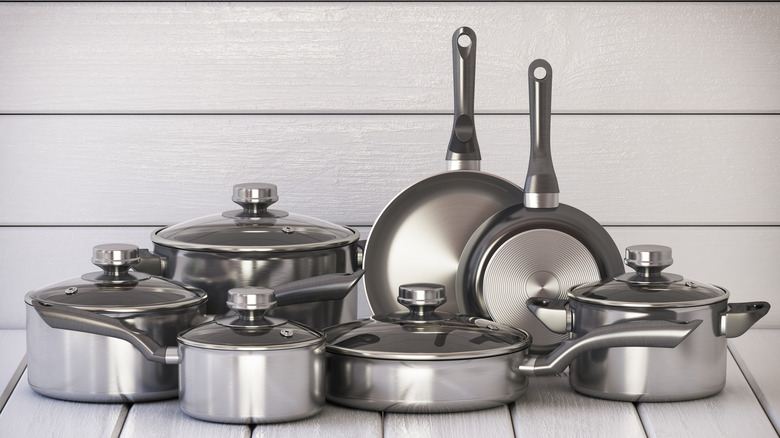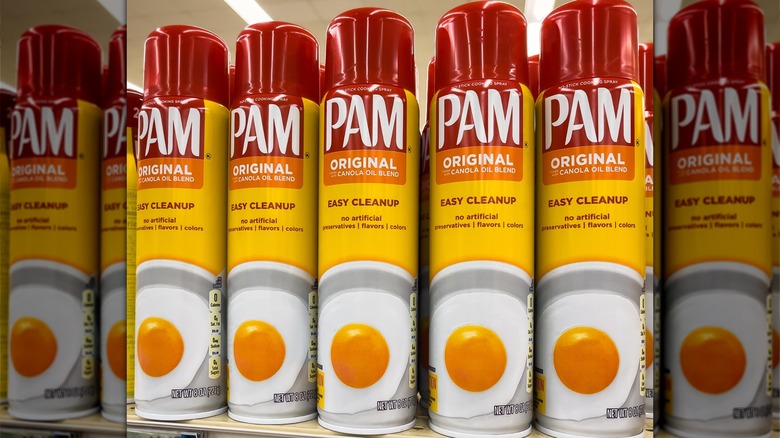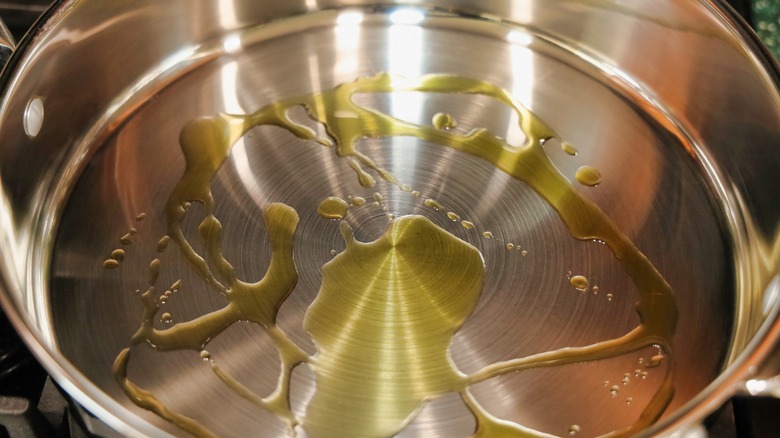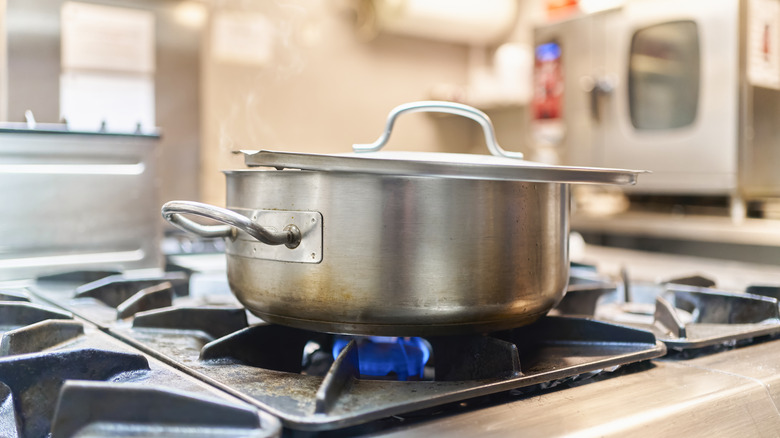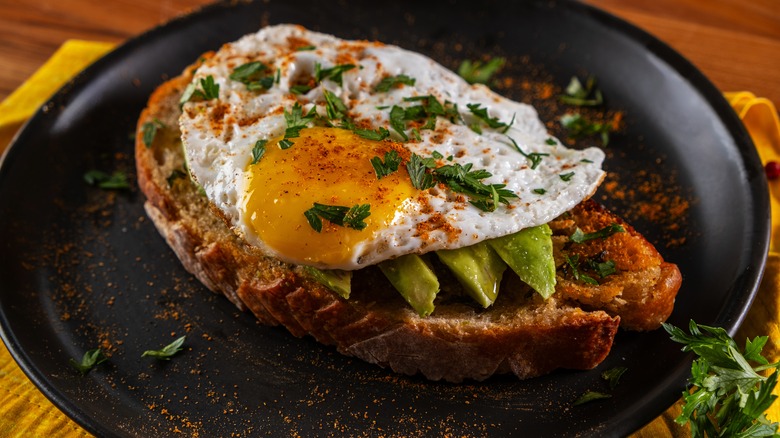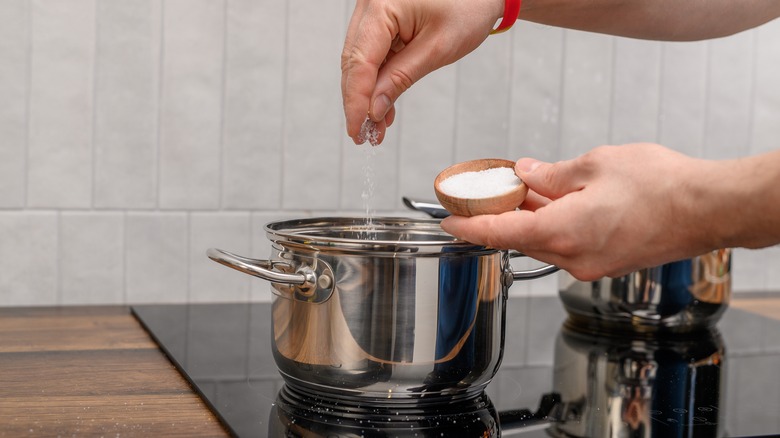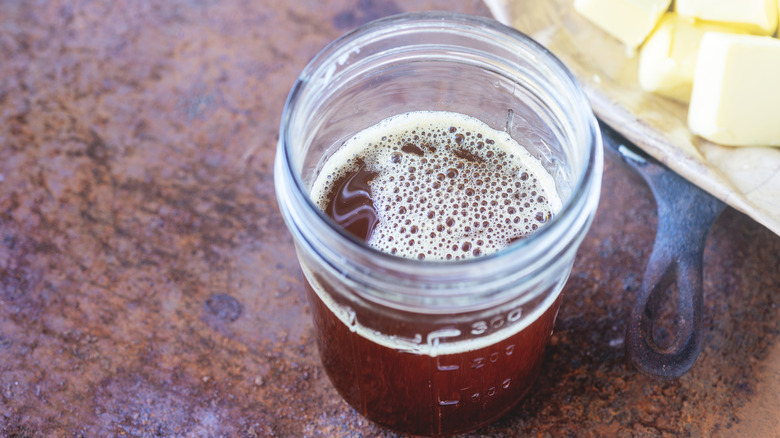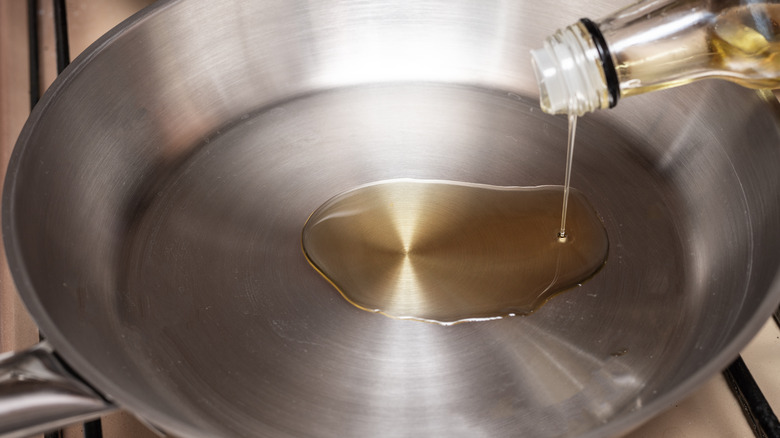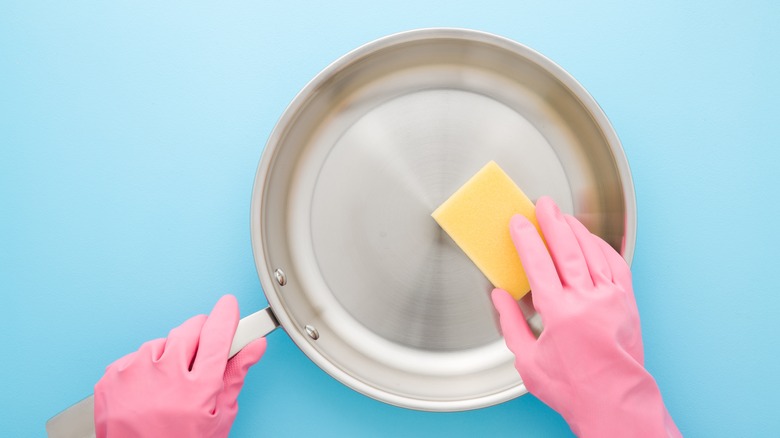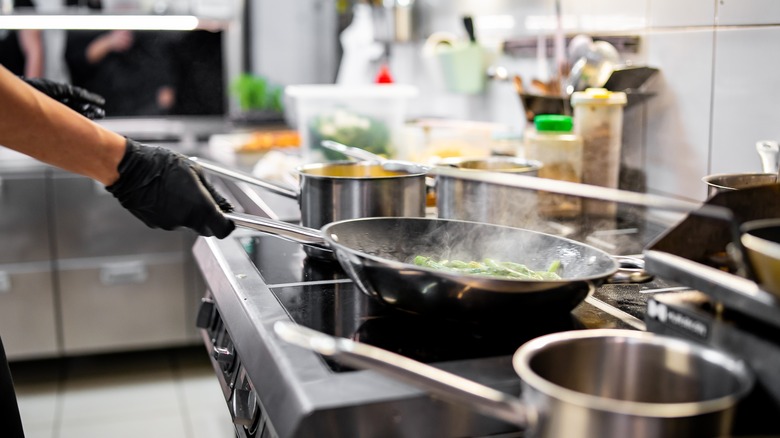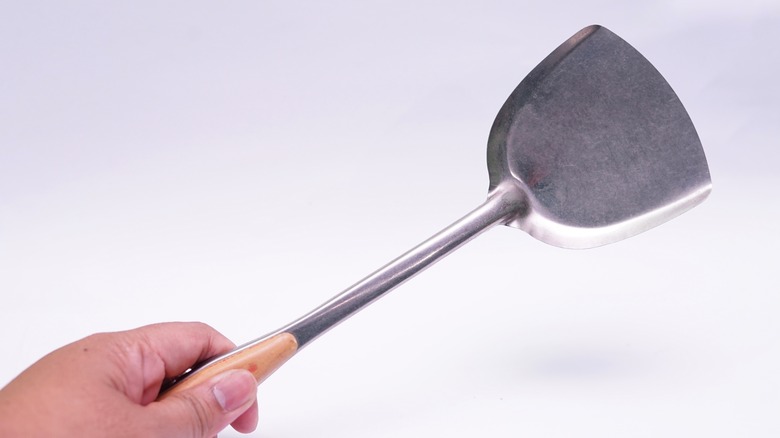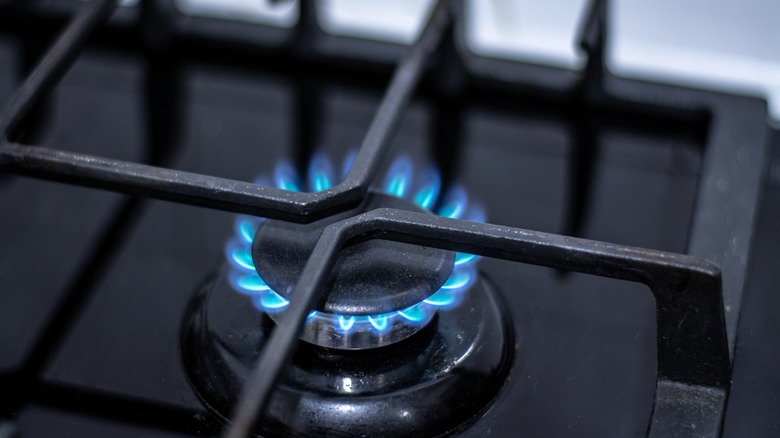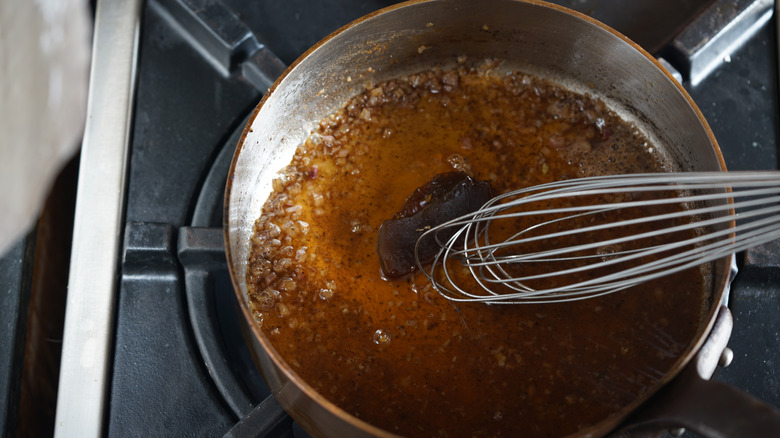Mistakes Everyone Makes When Cooking With Stainless Steel Pans
We may receive a commission on purchases made from links.
Stainless steel doesn't have the ease-of-use that comes from nonstick pans or the rustic charm of cast iron but it's still a great option when you know how to wield it. The trouble is, there are a range of mistakes everyone makes when cooking with stainless steel pans — and this is what gives them a bad reputation. Some people say that everything sticks to them or that they mark easily. But when you know how to use them correctly, this isn't the case.
There's a lot of nuance involved with stainless steel. For instance, you need to make sure you get pans hot enough to keep ingredients from sticking to them. And, they'd better be hot when you add the oil. Timing matters, as well. You need to know when to attempt flipping food and when to let it hang out in the pan for a bit longer. This might sound like too much to learn but, actually, once you get your head around it, cooking with stainless steel is quite simple.
If you want to learn the ins and outs of it, you've come to the right place. We're going to address the common mistakes people make with stainless steel pans. For each mistake, we'll explain how to fix or avoid it. So, you'll soon be a whizz with stainless steel pans and you'll wonder what all the fuss was about to begin with.
Using cooking spray
Some people find it more convenient to use cooking spray instead of oil. It's quick and easy to spray into a pan to prevent sticking. And, some people opt for it when they're trying to use less oil — which is understandable given the price of olive oil right now. However, what you might not know is that you should never use cooking spray on stainless steel pans. Most people don't realize this, which is why it's such a common mistake.
To understand why you shouldn't use cooking spray on stainless steel, you need to know what it is. Most folks mistakenly believe that it's just regular oil in a spray bottle. The truth is, it also contains a range of other ingredients, including propellants, solvents, emulsifiers, and other additives. It sounds a bit less appetizing now.
The issue comes from the use of emulsifiers. Their job is to keep the oil and other ingredients from separating. An unfortunate side-effect is that they leave a sticky coating on stainless steel cookware. The gummy residue gets stuck to the pan and is practically impossible to get off. The issue may be minimal at first, but repeatedly using cooking spray causes it to build up until you have a nasty coating that's tough to shift and can cause ingredients to stick.
Heating fats past their smoke point
All oil has a smoke point. This is the temperature at which it starts smoking when heated. Heating oil to its smoke point has various disadvantages, but the reason you shouldn't let it happen when cooking in a stainless steel pan is because this is when it starts to polymerize. This means the oil starts to turn into a resin that bonds to the surface of the pan. It doesn't dissolve in water, so it's tricky to get off.
This is actually the same process by which you season a cast-iron or carbon steel pan. But, most people aren't looking to season their stainless steel. Therefore, you don't want to create this layer that's a nightmare to shift. But, avoiding it is easier said than done. It's possible to accidentally heat oil past its smoke point. Try choosing an oil with a high smoke point — such as canola oil or peanut oil — when you know you'll be cooking foods on a high heat for extended periods. If you end up with a layer of polymerized oil in your pan, you can get it off with vigorous scrubbing, so it isn't the end of the world — but it is annoying for whoever's on dish duty.
Not getting the pan hot enough
Cooking with stainless steel pans can be tricky. Many people make the mistake of not heating their pans enough before adding food. This can lead to a big problem: sticky food that's hard to flip or remove from the pan.
When you heat a stainless steel pan properly, it creates an almost non-stick surface. This happens because the metal expands and its pores close up. A hot pan also helps create a crispy crust on foods like meat and fish. This crust not only tastes great but also makes the food easier to flip.
So how do you know if your pan is hot enough? You can use the Leidenfrost effect to test it. Put your pan on the stove over medium-high heat and let it heat up for a few minutes. When you think your pan might be hot enough, flick a few drops of water into the pan. If the water forms little balls that dance around the pan, it's ready. This happens because the water is floating on a layer of steam. If the water just sits there or evaporates quickly, the pan isn't hot enough yet.
Using this method can ultimately improve your cooking. Your food will be less likely to stick, and you'll get better results. It might take some practice, but it's worth it. So, be patient when heating your pan. Take the time to let it get hot enough and you might be surprised at the results.
Cooking cold eggs in a stainless steel pan -- or cooking eggs at all
One of the major complaints about stainless steel pans is that they're hard to cook eggs in. Many people find them fine to cook everything else in, but just can't get it right when it comes to eggs. If you're wondering how not to suck at cooking eggs in a stainless steel pan, we might have the solution.
One of the reasons why eggs tend to stick in stainless steel is because of temperature shock when adding cold eggs to a hot pan. As we mentioned above, when stainless steel heats, its pores close up, making food less likely to stick to the surface. However, when you add cold eggs, it makes the temperature drop and can open them back up again. This means the liquid eggs get stuck in these tiny pits, and you end up in a mess. All you need to do to fix this is bring your eggs up to room temperature when cooking them. The same goes for any other cold ingredients. If you find them sticking to your pan, don't put them in cold.
But, some people say you should never fry an egg in a stainless steel pan. They believe the risk of them sticking doesn't make it worthwhile. If you have a nonstick pan, it's certainly less of a gamble to cook your eggs in.
Using them on the grill
Although grills are more commonly used to cook food directly on them, you can also use pans. This is great when you want some fried onions to go with your burgers, for instance. But, using stainless steel on a grill is a big mistake. It can damage your pans, making you wish you'd stuck to the stovetop.
The reason you shouldn't use stainless steel pans on a grill is due to heat. They reach way higher temperatures than you might expect. A propane grill can reach 600 degrees Fahrenheit, while a charcoal grill can put out a whopping 1,200 degrees Fahrenheit. Stainless steel pans are designed to withstand the kinds of moderate heat experienced on a stovetop or in the oven. The heat from a grill can cause the metal to warp or even break down. And, even worse if they have any plastic or wooden parts that can melt or burn.
Adding salt to cold water in a stainless steel pan
Salting the water when you're cooking pasta or veggies is a must for a more flavorful meal. You might think it's fine to add the salt to the water while it's still cold, when you first put your pan on the stove. After all, if you get in the habit of doing it right away, you might be less likely to forget. It makes sense in theory, but it's actually a mistake.
You should always wait until the water is boiling to add salt. The reason for this is that salt drops to the bottom of a pan when the water is cold. With stainless steel pans, particularly, this can damage them. You might notice white marks on the bottom of a pan when you've been boiling salty water in it. This is called salt pitting and it's caused by adding salt to cold water. On the other hand, when you add salt to boiling water, it dissolves right away.
Some people believe that adding salt to cold water helps it boil faster, but this is untrue. The amount of salt in water makes no notable difference to the time it takes to simmer. So, there's no good reason to add salt to cold water in a stainless steel pan — and one big reason not to.
Not using stainless steel pans for browning butter
Not using your stainless steel pan to brown butter is a mistake that can leave your butter either overdone and burned or too pale and not flavorful enough. Brown butter is simple to make and elevates the flavor of an already delicious ingredient. But it can go wrong easily — which is where stainless steel can come to the rescue.
First, though, you might want to know more about brown butter. It's simply butter that has been heated until the milk solids separate from the fat and become toasted. This gives the butter its brown color and roasty, nutty flavor.
So, why stainless steel? It doesn't seem like it would make a difference what kind of pan you use. Well, the reason why you should use a stainless steel pan to brown butter is simply because of its color. If you use nonstick or cast iron, you won't be able to tell what color the butter is against the dark color of the pan. Stainless steel's silver hue lets you see exactly how dark the butter is, so you don't over- or undercook it.
Adding oil to a cold pan
When cooking with a stainless steel pan, it's important to wait until the pan is hot before adding oil. But, adding oil to a cold pan is a mistake many people make. If you add oil too early, the food might stick. That's because of the tiny pores on the surface of cold stainless steel pans. These pores trap food, making it harder to cook evenly and clean up afterward.
By heating the pan first, you allow it to expand slightly, which closes up those pores. Then, when you add the oil, it can spread out evenly and form a smooth, non-stick layer. This makes cooking easier and prevents sticking. When you don't wait, oil fills the gaps and then gets trapped in there as the metal expands and the pores close up. This leads to the sticking that stainless steel is known for. But, it's not really the fault of the material itself, it's a mistake on the part of people using it.
What's more, waiting for the pan to heat helps the oil cook the food at the right temperature. When oil goes into a hot pan, it reaches its cooking temperature faster. This can result in better browning and flavor. You'll notice oil quickly reaching a more liquidy consistency when you add it to a pan that's the correct temperature.
Cleaning stainless steel pans incorrectly
Many people make the mistake of not cleaning their stainless steel pans properly after they're done cooking. Caring for them properly takes extra time and effort, so we understand not wanting to. But it'll make them last longer and save you money in the long run.
To keep your pans in great shape, it's best to hand wash them, even if the manufacturer says they're dishwasher-safe. While it may seem easier to throw them in the dishwasher, hand washing helps them last longer and keeps them looking shiny. Before you start cleaning, always wait until the pan has cooled down. Washing a hot pan can cause it to warp or become damaged over time.
When you're ready to clean, use warm water, dish soap, and a soft sponge or cloth. Avoid using steel wool or harsh scrubbing pads, as these can scratch the surface of your pan. If food is stuck to the pan, let it soak in soapy water for a bit before gently scrubbing. After washing, don't forget to dry your pan with a dishcloth. Letting it air dry can lead to water spots or streaks. Drying by hand keeps the pan spotless and ready for the next time you need it.
Not considering seasoning stainless steel pans
We all know about seasoning cast-iron pans, but what about seasoning stainless steel? Most people don't even know that it's possible. And, while not everyone wants to season their stainless steel pans, it's something that you should at least consider.
For those not familiar with the seasoning process, we're not talking about sprinkling salt and pepper on your pans. What it involves is heating layers of oil in a pan until it polymerizes, turning hard and creating a nonstick coating. Seasoning works particularly well on cast iron and carbon steel because it bonds with the metal more easily. Since the surface of stainless steel is relatively smooth, when you season it, the built-up layers of oil aren't as tough or durable, so they're easier to wash off — but they still do their job.
If you want to season a stainless steel pan, start by heating it over a medium-high burner. Once it's hot, add a small amount of oil and spread it evenly over the surface of the pan with a paper towel. Keep heating the pan until the oil begins to smoke, then remove the pan and let it cool. It now has a nonstick coating that will help you keep eggs and other particularly troublesome foods from getting stuck to the pan. It's a temporary coating, though. It will only last through a wash or two.
Flipping food too early
When you're cooking food in stainless steel pans, it's easy to make the mistake of trying to flip your food too early. If you attempt to flip foods before they're ready, they often stick to the pan. This can lead to torn or unevenly cooked food — and it makes cleaning the pan harder too.
The trick is to let the food cook long enough on one side before flipping. As it cooks, a natural crust forms, which helps release the food from the pan. If you give it time, the food will lift off easily when it's ready. If it's still sticking, it's a sign that it needs more time.
To avoid rushing, keep an eye on your food and listen for cues. For example, with some foods, you may hear a steady sizzle while they're cooking. Once the sizzling quiets down a bit, that's often a sign the food is ready to flip. You can also gently test the food with a spatula. If it feels stuck, wait a little longer. Patience really is a virtue when you're cooking with stainless steel pans.
Turning the heat up too high
If you've been turning up the heat while cooking in your stainless steel pans, you're not alone. But, it's a mistake you should aim to avoid. Most of the time you should stick to a medium heat with stainless steel. Using too much heat can damage your pan and even ruin the food you're cooking. This metal heats up quickly and holds heat well, so there's usually no need to turn the burner up high.
High heat can cause your food to burn on the outside before it's cooked through on the inside. It can also cause the pan to warp over time, making it harder to cook with. The only time you should use high heat is when boiling liquids like water or broth. For everything else, such as sautéing vegetables or cooking meat, medium heat is usually enough.
By keeping the temperature under control, you'll get better results in the kitchen. Your food will cook evenly without sticking or burning, and your pan will last much longer. Yes, it means you need to be a little more patient, but moderate heat will usually get the job done.
Not deglazing the pan
Of course, there's no rule to say you always have to deglaze a pan, but if you aren't doing it with your stainless steel pans, you're missing out. The fact that food is more likely to stick to stainless steel is often seen as a downside. However, it has a benefit. These stuck-on bits caramelize and become richly flavorful. This makes them the perfect base for a sauce — and it's easy to make this sauce by deglazing the pan. Stainless steel is also particularly good for deglazing because it can handle the temperature changes involved.
First, you might need to understand more about deglazing. Basically, it simply involves adding liquid — such as stock, wine, or even just water — to a pan that's on the heat and using this liquid to remove stuck-on bits from the bottom of the pan. They'll eventually dissolve in the liquid and form the base of a sauce. If you're using wine in this sauce, you should simmer it until it reduces by half to help thicken the sauce and get a better flavor. You can add aromatics and cream to flavor the sauce further.
